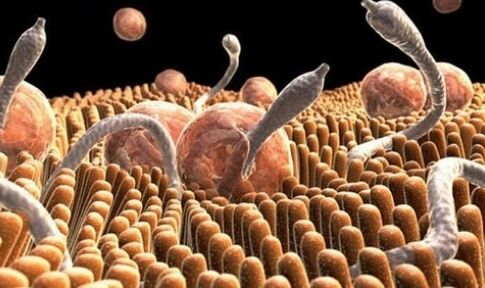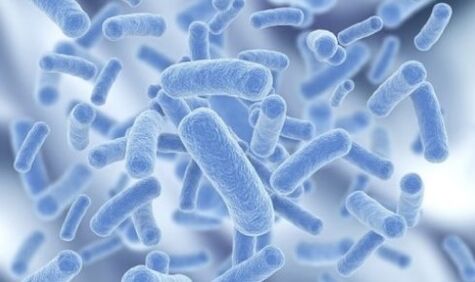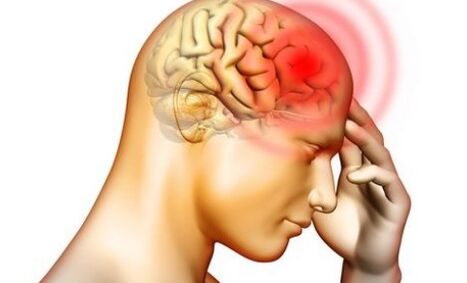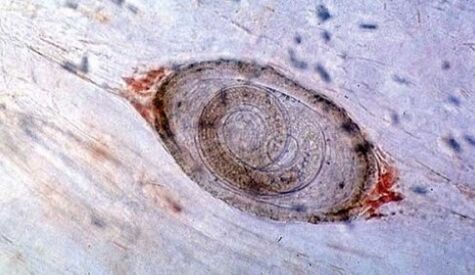Human parasites are called all organisms living for it. These are bacteria, fungi, worms. Human parasites are divided into internal and external. The most unpleasant and causing the largest number of body destruction are helminths -a variety of parasitic worms.
Creatures parasitizing on the human body can be external or internal. The outside includes:
But there are many more creatures who prefer to settle inside the body. These include:
The external and internal organization of the parasite belongs to the simplest. Due to the fact that it is not necessary to develop in the name of survival, their organization is significantly simplified.
There are many creatures who prefer to settle inside the body. For example, it can be bacteria.
They cannot survive without the body of the hosts, unable to receive their own food. But they all multiply, almost without exception, very quickly, especially in the conditions that are appropriate for it. Where they were not immediately expelled.
Differ territorially. Some can be found everywhere, no climate for them is an obstacle. Others live exclusively in tropical countries, but they can easily be brought to anyone else. In the body, they are also established in different places.
The cycles of the development of parasites, mainly helminths, are also diverse. Some initially develop into the ground (biohelmints) and then move to a living being. Others must first develop in the body of any other living being, but not human. Third, in an adult state, you can transfer to another or re -activate.
It is wrong to assume that the infection can occur exclusively through dirty hands. Eggs from some helminths have been viable outside the nutrient medium for six months and perfectly cling to animal wool. Eggs survive in a dangerous environment for them - it is worth cooking meat or fish incorrectly as you can pay a whole breeding of worms.
It is worth cooking the meat incorrectly, how you can pay a whole breeding of worms.
The parasites are divided into endoparasites and ectoparasites. Endoparasites - those who settle inside, ecto - outside. Endoparasites are able to precipitate in almost all internal organs and body tissues. They are divided according to the location. The endoparasites are:
They settled right in those organs that were related to the external environment, not vice versa: the parasitic body was not chosen to "breathe". Such organs include the intestines, light, human urine system. These are amoebas, worms and burning parasitic.
Tuned in human blood. They can live in plasma, white blood cells, red blood cells. These are tripanosomes, microfilaria or hemosporidia.
These endoparasites that choose the tissues of the body with their place of residence. Muscle tissue, brain, cartilage, connector. Even in nerve fibers, tissue endoparasites can settle. These are striptease worms, tripanosomes, myxosporidia, trichina and others. 
Endoparasites can choose the brain with their place of residence.
Determining the variety of parasite at the site of its localization is very conditional. Many species are able to migrate in different internal organs, regularly travel with the owner's body. The distribution process can occur in one place, and organisms will be directly and feed on another. The place where the parasite is justified and will be considered as the place of its conditional localization.
Despite the simplification of many parasitic systems, their life cycle is quite complicated.
Some varieties throughout their lives for survival must change several owners that can relate to different biological species. Others are able to survive only one biological appearance inside, but may require intermediate hosts. In one person they multiply and in another develop and grow. With such a complex life cycle, their sexual functions increase significantly. It is necessary to multiply quickly for survival in the parasites of the body quickly and much.
There are three main varieties of helminths, also called worms. This:
They can then be separated from the life cycle and the number of places that pass this route. There are also three types:
Geo-Shelmints.
"GE" is the earth. These worms begin their existence on the earth's soil, only after the stage of maturation can they infect a person. They do not need intermediate hosts, the eggs fall into the soil along with human stools. For the stage of the larvae, they develop exclusively in the warm season.
Such worms include Ascarides, intestinal ultras, some and Blazo -Hads.
The larvae of these parasites can enter the human body through unwashed vegetables or direct contact with the soil.
BioHelminths.
These are parasitic worms, the stages of life that go through several owners. The intermediate hosts can be two or more depending on the variety of worms. Some parasites change extremely human. Others, before finally enter the human body, are used by organisms of other biological beings for development.
You can infect pets or in contact with other people, also when you consume half -destroyed meat. BioHelminths include bull tapeworm, echinococcus, wide ribbon, trichina and more.
Contagioine Helminths.
These worms do not need soil or intermediate owners. They pass all stages of their life cycle in an organism, very comfortably located. The larvae stand out directly from the human body when connecting to household surfaces and other people, spreading freely.
Helminants can live in different organs and systems of the human body, periodically migrating from one part of the body to another.
The list of disease caused by helminths is very extensive. Determine which parasites live in the body and what treatment can only begin after all the analyzes needed to determine the type.
The broadest widespread in the human environment were round worms, also known as nematodes. There are more than 24, 000 types of nematodes in the world.
They are round because of their shape, which is detected if you make a transverse cut. The most common human nematodes:
The helminth invasion, known as ascariasis, begins with direct contact with the larvae infected with soil or using unwashed fruits and vegetables. The parasites begin to develop in the intestine, after which they enter the circulatory system of a person from where they go to different internal organs, heading to the oral cavity. A person, without noticing this, repeatedly absorbs an adult parasite. They feed on the remains of undigested food. Ascaris waste is extremely toxic. There is no ascariasis vaccine, the infection can be prevented exclusively by complying with the rules of personal hygiene.
Pinburic infection is called enterobiasis. These are small worms (5-10 mm) attached to the walls of the intestine. They feed on blood and bowel content. They put their eggs under the skin, coming out of the anal opening out while the owner sleeps. Due to itching, a person who rotates the anal area, the larvae fall under the skin and hands can easily be transferred to other people in the house or in public places. Enterobiosis has no painful symptoms, the detection of pinkor infection at the initial stage is extremely problematic.
Trichinella, they are a trichina, these are round worms that choose an animal or a person with their master.
Trichinella is a parasitic worm that affects the human body, causing a dangerous disease of the trichinosis vermis.
They begin to develop in the area of the cross muscles in the body, and then redirect to the small intestine. In advanced cases of infection per kilogram of muscle tissue, about 15, 000 eggs per trichinella can be located. These parasites can cause a deadly disease named after its source, trichinosis.
The round worms of the blazes are called because of their appearance. The front of their body is a thread, it contains an esophagus.
The back is wider, the other internal organs of the parasite are located in it. The length of the blends can reach 50 mm. It feeds on blood as well as tissue fluid. Causes the disease of trichocephalosis.
There are about 3, 500 species of known worms in the world, the type of which is also called cestodi. These flat worms have no digestive systems at all, and the diseases they cause are called cestodosis.
The most common cestodosis:
Cystyrocardia. The disease of larvae of pork tapeworm is excited, entering into contaminated food, from dirty hands. The disease affects the skin, bones, internal organs, brain and spinal cord. Most often, parasites are sent to the brain (in 60% of cases of infection). It is diagnosed on the basis of the appearance of rounded skin formations. The disease is treated in the case of infection of the central nervous system, prognosis can be unfavorable. Echinococcosis. Localized in the liver, lungs, many other internal organs. Echinococcus larvae excite the disease. They can develop within a person for several years. The infection is carried out on contact with animals, the collection of fruits and fruits, consumption of contaminated water. The disease is not too noticeable, it can develop for years and has only been revealed by accident. Alvekoscosa. Alveokocosis is caused by Alveocococcus worms. The disease is similar to echinococcosis, but it is more severe. It affects the lungs and kidneys. Without the treatment of the disease, there is a high probability of a fatal result in relation to the development of liver failure. Tonaryhosis. Tuziarinchosis is caused by a bull chain. The parasites tapeworm in the small intestine area develops in 2, 5-4 months. Prognosis are more often favorable for treatment. Parasites can enter a person with infected raw or insufficiently processed thermal meat. The rough worms are very fertile. They are the most lowered of the rest of the sensitivity and there is no digestive system at all. Such parasites are not able to develop without the owner. The supreme is tremony. These are flat worms in the shape of your body, resembling an elongated leaf of wood. Some types of trematodes can reach a size of one and a half. And they find themselves in the human body, they are most often through fish or other seafood. About 7200 species of trematodes are known, 40 of them are found in humans and cause trematodoses, serious illnesses caused by infection. The most common salaries: Liver Bikom. Globally it can exist in animals and humans. The biological life cycle is complex, the parasite changes owners. Schistosome. Schistosomal larvae can penetrate the skin or mucosa. The life cycle is complex, feeding on blood. A woman is able to produce about 3000 eggs a day, the fertility of these parasitic worms is very high. Other liver bale. Opistorchiasis, a helminth disease, widespread in the liver area. The human body has a toxic effect. The digestive system of worms is well developed with IT-sexual and excretory. Other systems develop weakly. The tremony feed on blood, epithelial skin cells, the contents of the intestine. They can live almost anywhere: from the liver to the conjunctival eyes of the eyes. Other internal parasites are different bacteria that cause dangerous diseases and with them the simplest microorganisms. The fungi that spread inside the human body also refers to the area of endoparasites. Very useful and harmful microorganisms live in the human body. Some of them cause quite dangerous diseases that can lead to death. It is not always possible to immediately recognize the presence of parasitic beings in yourself, but early diagnosis of infection gives more chances to complete treatment. If the invasion is suspected, it is recommended that you have a complete examination by a doctor quickly.
























